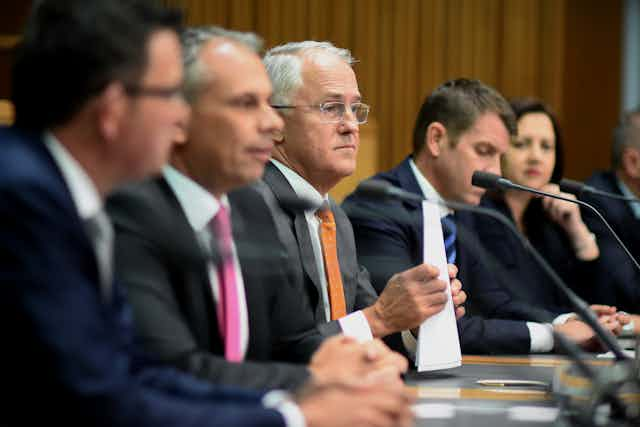State and territory leaders today agreed to a three-year interim hospital funding deal to meet some of the shortfall left by the 2014 Commonwealth budget cuts.
Under the Council of Australian Governments (COAG) agreement, states will receive an additional A$2.9 billion from July 2017 to June 2020, with growth in Commonwealth funding capped at 6.5%. A longer-term arrangement will then be put in place.
In return, state and territory leaders agreed to improve the quality of health care to keep people out of hospitals and reduce the number of avoidable re-admissions.
The leaders supported the Commonwealth’s Health Care Homes trial, announced yesterday, which aims to better coordinate the care of people with chronic diseases.
But there was no consensus from the leaders on Prime Minister Malcolm Turnbull’s income proposal for states to levy their own income tax.
The Conversation’s experts respond.
Stephen Leeder, Emeritus Professor, Menzies Centre for Health Policy at the University of Sydney:
The agreement negotiated today should surprise no-one, as the cuts to health budgets proposed in 2014 were so absurd that they could not be taken seriously.
So now the states and territories will have the money to continue to meet basic needs for hospital services.
The commitment of the states and territories to improve the quality of their care is commendable. But I know of no Australian jurisdiction that has a strategic commitment to not improve quality or to feel fully satisfied with what they are doing.
Avoidable re-admissions make absolutely no sense to anyone, least of all the patients, so minimising these goes without saying also. The question is, “how?”
The interesting element in the agreement is the commitment to testing new ways of managing patients with complex and continuing illnesses. These programs of care will link up the services they require from hospitals, general practitioners and community services, as proposed by the Hambleton review of primary care.
There is evidence of benefit from similar trials to patients’ quality of life. This program has the capacity to improve care and decrease the need for hospital stays because crises in the lives of people with these problems can be prevented with good community support.
Let’s hope this trial gets a fair go.
Peter Sivey, Senior Lecturer, Department of Economics and Finance, La Trobe University:
The Commonwealth’s commitment to increase funding to public hospitals between 2017 and 2020 is welcome. Public hospitals are the front line of our complex health system and spending money on them is highly progressive: they treat the most disadvantaged patients who have nowhere else to turn.
Under the agreement, the Commonwealth will fund 45% of the growth in activity-based funding (i.e. for each operation or procedure) over the period but caps funding growth at 6.5% per year.
The government is so convinced by the principle of activity-based funding that the agreement insists it be used across the country.
But if population and other determinants of health-care demand grow strongly in the coming years, hospitals will hit the cap and be effectively working under a “block grant” with no incentive to improve their efficiency.
The agreement claims initiatives to improve quality of care “to keep people out of hospitals” will also contain costs. But while quality improvement efforts in primary care and in reducing readmissions to hospital are laudable, I am sceptical of their role as a cost saving measure in the long run. Reducing hospital admissions overall is notoriously difficult.
It would be nice to see the current debate over cutting waste in Medicare linked to funding public hospitals. For example, the A$3.7bn a year spent on subsidising private in-hospital procedures benefiting mainly the more affluent could be cut to fund public hospitals.
Lesley Russell, Adjunct Associate Professor, Menzies Centre for Health Policy, University of Sydney:
As with all such agreements, the devil is in the details, and there are very few details here, especially given the short time frames.
Are there realistic expectations that the Commonwealth–state efforts to reduce pressures on public hospitals will be fully developed, implemented and delivering evaluated results by July 2020 when the agreement ends, let alone by 2018 when it is proposed the next agreement is developed?
There is evidence from the United States and the United Kingdom’s National Health Service that financial penalties can lead to improvements in quality and safety and readmission rates. But there are also cautions: such reporting systems can be gamed and the focus becomes on what is being measured, crowding out other factors.
The Health Care Homes proposal is welcomed but will struggle to deliver hoped-for changes in care in an environment where clinicians’ Medicare fees are frozen, patients’ out-of-pocket costs are growing, and primary prevention and tackling the social determinants of health are not seen as a federal responsibilities.
To date there has been no mention of workforce requirements, so it is not clear how busy GP surgeries will deliver on issues such as patient transport, house cleaning and home modification needs, as highlighted in the health minister’s examples.
Our disjointed health care system/s need reforms, especially at the interfaces. And reforms require upfront investments, even if they will ultimately deliver returns on those investment. This agreement is about delivering an election, not the needed long-term reforms.

